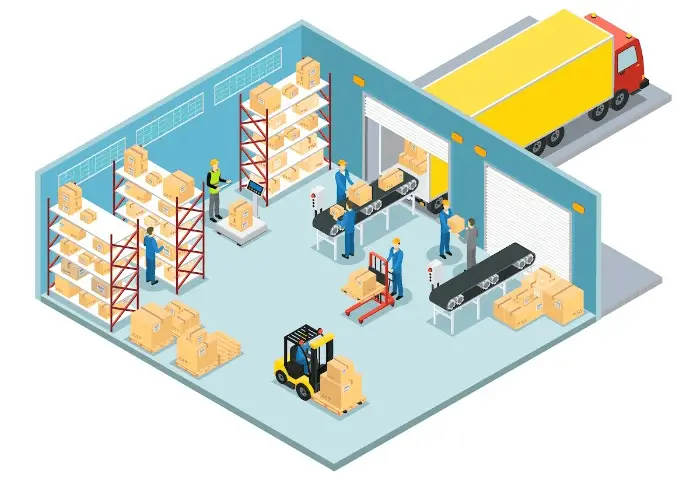

The pick, pack, and ship process is a crucial component of successful warehouse management and order fulfillment. In this comprehensive guide, we will take you through each stage of the process, from receiving inventory to shipping orders. Our goal is to provide valuable insights and practical tips for warehouse professionals looking to streamline their operations and improve customer satisfaction. Whether you’re a warehouse manager, operator, or staff member, this guide has everything you need to optimize your pick, pack, and ship process.
Receiving: Laying the Foundation for Success
The receiving process sets the stage for efficient warehouse operations. It involves the following steps:
- Inspection: Warehouse staff inspects incoming shipments to verify the quantity and quality of the items. Any discrepancies or damages must be reported to the supplier promptly. It’s essential to implement a clear communication channel with suppliers to resolve any issues quickly.
- Organization: Items are strategically organized in the warehouse, taking into account factors such as product type, demand, and storage requirements. Proper organization ensures easy access to items during the picking process. Warehouse managers should consider employing different storage systems, such as pallet racking, mezzanines, and shelving units, to maximize storage capacity and accessibility.
- Inventory Updates: Accurate data entry into the warehouse management system (WMS) or inventory management system ensures real-time inventory visibility, which is essential for effective order fulfillment. Warehouse staff should be trained in using barcode scanners and other tools to automate and streamline data entry processes.
- Standard Operating Procedures (SOPs): Developing and implementing SOPs for receiving processes can help ensure consistency and efficiency across the warehouse. SOPs should cover topics like unloading shipments, inspecting items, managing damaged goods, and updating the inventory management system.
Inventory Management: The Heart of Warehouse Operations
Efficient inventory management is critical for optimizing warehouse operations. Key aspects of inventory management include:
- Inventory Tracking: Warehouse staff must keep track of stock levels, warehouse locations, and shipping orders, using inventory management software like Logimax. Accurate inventory tracking is vital to prevent stockouts, and overstock situations, and ensure timely order fulfillment.
- Demand Forecasting: Accurate demand forecasting allows warehouse managers to plan for future inventory needs, minimizing stockouts, and overstock situations. Analyzing historical sales data, seasonal trends, and promotional events can help improve the accuracy of demand forecasts.
- Cycle Counting: Regular cycle counting ensures inventory accuracy, preventing costly errors and delays in order fulfillment. Instead of conducting full physical inventory counts, warehouse staff performs counts on a rotating schedule, allowing for continuous inventory accuracy checks.
- Safety Stock: Maintaining a safety stock buffer helps mitigate the risk of stockouts due to unexpected demand spikes or supply chain disruptions. Warehouse managers should carefully calculate safety stock levels based on demand variability and lead times.
The Picking Process: Retrieving Items for Packing
The picking process is where warehouse staff collect items from storage locations to fulfill customer orders. The efficiency of the pick pack ship process relies heavily on choosing the right picking method for your warehouse. There are various picking methods, each with its advantages and drawbacks:
Zone Picking:
Staff are assigned to specific zones within the warehouse and pick items only from their designated zone, reducing travel time. Zone picking can be further optimized by implementing dynamic zone assignments, which adapt to changes in order volume and item popularity.
Batch Picking:
Items for multiple orders are picked simultaneously, optimizing the picking process for businesses with multiple sales channels and similar product types. To maximize efficiency, warehouse managers can use software algorithms to group orders with similar items or warehouse locations.
Wave Picking:
A hybrid of zone and batch picking, staff pick items from designated zones in batches, combining the benefits of both methods. Wave picking can be tailored to specific warehouse needs, with waves scheduled based on factors like order priority, shipping cutoff times, or carrier pickup schedules.
Ready to Streamline Your Pick, Pack, and Ship Process?
Discover how Logimax WMS can optimize every step of your order fulfillment. From receiving to shipping, our comprehensive system ensures accuracy and speeds up operations, enhancing customer satisfaction and driving business growth.
Discover MorePiece Picking:
Staff pick individual items for a single order, suitable for small eCommerce companies or businesses with high levels of customization. To optimize piece picking, warehouse managers can use technology like pick-to-light systems, which guide pickers to the correct items and quantities.
Consolidation:
After the picking process, items from different zones or batches may need to be consolidated before packing. This step can be optimized through the use of conveyor belts, automated sortation systems, or robotics to ensure items are correctly grouped for packing.
Choosing the right picking method for your warehouse or fulfillment center can significantly impact the efficiency of your operations.
Technology in the Picking Process
Emerging technologies can greatly improve the efficiency and accuracy of the picking process:
- Pick-to-Light Systems: These systems use light indicators to guide pickers to the correct items and quantities, reducing errors and increasing productivity.
- Voice Picking Systems: Voice commands direct staff through the picking process, allowing hands-free operation and reducing errors caused by manual data entry.
- Robotics and Automation: Autonomous robots and automated guided vehicles (AGVs) can be used to transport items between zones, reducing travel time and human labor.
- Wearable Technology: Wearable devices, such as smart glasses and wrist-mounted computers, can provide real-time picking instructions and inventory information, improving the efficiency and accuracy of the picking process.
The Packing Process: Preparing Items for Shipping
Proper packing is essential to ensure customer satisfaction and minimize the risk of damage during shipping:
- Packing Materials: Appropriate packing materials, such as bubble wrap, packing peanuts, and sturdy boxes, should be used to protect items during transit. Warehouse managers should regularly evaluate and update packing materials to ensure optimal protection and cost efficiency.
- Packing Strategies: Implementing packing strategies, such as box-sizing algorithms, can help minimize shipping costs and reduce waste. Staff should be trained to use the most efficient packing methods for each order type, taking into account factors like item fragility and shipping carrier requirements.
- Packing Station: A well-organized packing station, equipped with packing materials, shipping labels, and necessary tools, can greatly improve packing efficiency. Implementing ergonomic workstation designs can also reduce worker fatigue and improve productivity.
- Custom Packaging: Custom packaging solutions, such as branded boxes or personalized packing materials, can enhance brand image and customer satisfaction. Warehouse managers should weigh the costs and benefits of custom packaging and consider integrating it into their operations.
- Quality Control: Staff should check items against the picking list and sales order to ensure order accuracy and customer satisfaction. Implementing quality control measures, such as barcode scanning and automated weighing systems, can help reduce errors and minimize returns.

The Shipping Process: Getting Orders to Customers
The final stage of the order fulfillment process is shipping, which involves preparing and dispatching orders to customers:
- Shipping Labels and Documentation: Accurate shipping labels and documentation are essential for efficient shipping. Warehouse management software, like Logimax, can automatically generate shipping labels, packing slips, and other necessary documentation, reducing errors and saving time.
- Shipping Provider Integration: Integrating shipping providers with your warehouse management software streamlines shipping operations. Logimax supports integration with various shipping providers, allowing you to manage and track shipping orders, tracking numbers, and tracking information all in one place.
- Shipping Best Practices: Following shipping best practices, such as using appropriate packing materials, quality control, and accurate shipping labels, helps minimize shipping errors and ensures customer satisfaction. Additionally, maintaining open communication channels with shipping providers and customers helps resolve any issues that may arise during the shipping process.
- Shipping Rate Optimization: Warehouse managers should regularly evaluate shipping rates and negotiate with carriers to ensure cost-effective shipping options. Implementing a multi-carrier shipping strategy can also help optimize shipping rates and provide more flexibility in shipping options.
- Shipping Analytics: Analyzing shipping data, such as delivery times, shipping costs, and carrier performance, can help identify areas for improvement and cost reduction. Warehouse managers can use this information to make data-driven decisions and optimize shipping operations.
Returns Management: Handling Customer Returns
Efficient returns management is crucial to maintaining customer satisfaction and minimizing the impact of returns on your business:
- Return Policies: Clear and concise return policies help set customer expectations and reduce the number of unnecessary returns. Ensure that your return policy is easily accessible and communicated to customers during the purchasing process.
- Return Merchandise Authorization (RMA) Process: Implementing an RMA process can help streamline returns management by providing customers with a structured method for returning items. Warehouse management software, like Logimax, can support the RMA process by generating RMA numbers, tracking returns, and updating inventory accordingly.
- Inspection and Restocking: Returned items should be inspected for damage or defects before being restocked or disposed of. Warehouse staff should be trained to identify and categorize returned items appropriately.
- Returns Analytics: Analyzing return data can help identify trends and patterns, allowing warehouse managers to address the root causes of returns and implement preventative measures. Returns analytics can reveal valuable insights into product quality, customer satisfaction, and operational efficiency.
Continuous Improvement: Optimizing Warehouse Operations
Warehouse managers should continually strive to improve operations by implementing new technologies, processes, and strategies:
- Key Performance Indicators (KPIs): Identifying and tracking KPIs, such as order accuracy, order cycle time, and picking productivity, can help measure warehouse performance and identify areas for improvement.
- Employee Training and Development: Providing ongoing training and development opportunities for staff in warehouses and fulfillment centers helps ensure they have the skills and knowledge to perform their roles effectively. Training should cover topics such as safety, equipment operation, inventory management, and picking techniques.
- Lean Warehouse Management: Applying lean principles to warehouse management can help identify and eliminate waste, improve efficiency, and reduce costs. Lean techniques, such as value stream mapping and 5S, can be applied to various aspects of warehouse operations.
- Technology Adoption: Staying up-to-date with the latest advancements in warehouse technology can help improve efficiency, accuracy, and overall performance. Consider integrating new technologies, such as warehouse management software, automation, or IoT devices, into your operations as they become available and cost-effective.
Minimizing Human Error in Pick and Pack Operations
Human error can have a significant impact on the efficiency and accuracy of pick and pack operations. Warehouse managers can implement various strategies to minimize human error, ensuring a more efficient route for fulfilling orders.
Accurate Inventory Storage and Tracking
Maintaining accurate inventory storage and tracking is crucial for reducing human error in the pick and pack process. Warehouse managers should ensure that warehouse shelves are organized and inventory is accurately tracked using an all-in-one solution like Logimax. This allows the warehouse manager, who is responsible for overseeing the entire warehouse operation, to quickly locate and retrieve items, minimizing the risk of picking errors.
Training and Development for Warehouse Staff
Providing comprehensive training and development opportunities for warehouse staff can help reduce human error in pick and pack operations. Staff should be trained in the correct use of packing slips, shipping labels, and packing materials, as well as the various pack methods and strategies relevant to the fulfillment or eCommerce businesses they serve.
Quality Control Measures
Implementing strict quality control measures can help identify and address human errors before they impact the end customer. Regular checks should be performed throughout the pick and pack process, including verifying the entire order against the packing slip and ensuring the correct shipping label and tracking number are applied.
Importance of Pack Fulfillment in Pick and Pack Operations
Pack fulfillment plays a critical role in ensuring the accuracy and efficiency of pick and pack operations. Warehouse staff must be trained in various pack methods and pack strategies to guarantee that items are properly prepared for shipping, minimizing the risk of damage and improving customer satisfaction.
Tailoring Services to Different Businesses
Different businesses have unique requirements when it comes to pick and pack services. Understanding the specific needs of each eCommerce business can help warehouse managers develop customized solutions to streamline their pick and pack warehouse operations. This may include implementing different picking and packing methods or using specialized software solutions tailored to the business’s needs.
Conclusion
Efficient pick, pack, and ship processes are essential for successful warehouse management and order fulfillment. By understanding and optimizing each stage of the process, from receiving to shipping, warehouse managers can streamline operations, reduce costs, and improve customer satisfaction. This comprehensive guide provides a solid foundation for warehouse managers looking to enhance their pick, pack, and ship processes. By implementing the strategies and techniques outlined in this guide, warehouse managers can increase productivity, reduce errors, and ensure timely and accurate order fulfillment.
If you’re looking for a comprehensive inventory and warehouse management software to streamline your warehouse operations, consider Logimax. With features like real-time inventory tracking, automated data entry, and shipping provider integration, Logimax WMS can help you optimize your pick, pack, and ship processes. Contact us today to learn more about how Logimax can help your business.



